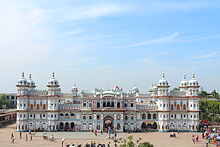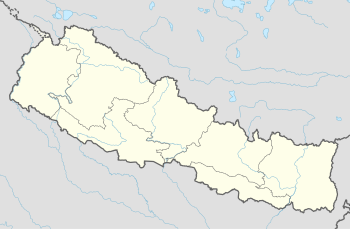Tourism in Nepal
This article contains promotional content. (April 2024) |

Tourism is the largest industry in Nepal and its largest source of foreign exchange and revenue. Home to eight of the ten highest mountains in the world, Nepal is a destination for mountaineers, rock climbers and adventure seekers. The Hindu and Buddhist heritages of Nepal and its cool weather are also strong attractions.[1]
Overview
[edit]
Mount Everest, the highest mountain peak in the world (8,848.88m above the sea level), is located in Nepal. Mountaineering and other types of adventure tourism and ecotourism are important attractions for visitors. The World Heritage Site Lumbini, birthplace of Buddha, is located in the south of the West region of Nepal (which despite the name is located in the center of the country) and there are other important religious pilgrimage sites throughout the country. The tourist industry is seen as a way to alleviate poverty and achieve greater social equity in the country. Tourism brings $471 million a year to Nepal.[2]
According to statistics of 2019, there was a growth rate of 2.1%. According to statistics from Nepal Tourism Board (NTB), a total of 1,197,191 foreign tourists entered the country in 2019 as compared to 1,173,072 in 2018. The government of Nepal declared 2011 to be Nepal Tourism Year, and hoped to attract one million foreign tourists to the country during that year.[3] The government of Nepal has also declared Lumbini Tourism Year 2012 to promote Lumbini. The government of Nepal has also recently declared Visit Nepal 2020 with the aim of bringing in two million tourists by 2020.
Most of tourists visit for short stays. In 2022, 64.7% of the tourists came to Nepal for holiday vacations,10.03% came for adventure, such as trekking and mountaineering, 12.87% came for religious visits, and 12.39% for other reasons. Tourists who come from the USA, UK, France, Spain, India, and Germany have a main target of activity: mountain climbing. Mt. Everest, Mt. Ama Dablam, and Mt. Manaslu are the most popular mountains.[4]
The tourism industry of Nepal was affected after the destructive earthquake in 2015, by the series of earthquakes in 2015. In 2020, the tourism sector in Nepal collapsed due to the COVID-19 pandemic.[5]
In 2022, tourism income increased by 190% from 2021. The gross foreign exchange earnings were Nrs 46,756,824 thousand (Around 326,282 thousand US$).[4]
Religious sites
[edit]
The most followed religion in Nepal is Hinduism, and the Pashupatinath Temple, the world's largest temple of Lord Shiva, located in Kathmandu, attracts many pilgrims and tourists. This is arguably the most famous Hindu temple in the Indian Subcontinent. Adjacent to the temple, lies a crematorium where bodies are burned to ashes. Pashupatinath is also listed in UNESCO heritage sites.[6] Other Hindu pilgrimage sites include the temple complex in Swargadwari in the Pyuthan district; Janaki Mandir in Janakpurdham in Mithila region; Lake Gosainkunda near Dhunche; the temples at Devghat; Kalinchowk Bhagwati Temple in Dolakha; Manakamana temple in the Gorkha District; Pathibhara near Phungling; Galeshwordham Myagdi and Mahamrityunjaya Shivasan Nepal in Palpa District where the biggest metallic idol of Lord Shiva is located.
Buddhism is the second largest followed religion in context of Nepal. The World Heritage Site at Lumbini, which is considered to be the birthplace of Gautama Buddha, is an important pilgrimage site. Another prominent Buddhist site is Swayambhunath, the Monkey Temple, in Kathmandu.

Dang valley is a sacred place for Hindus as well as other religions. Kalika and Malika Devi in Chillikot hill, Ambekeshawori temple, Krishna temple, Dharapani temple are among the sacred places in Dang district. Chillikot hill is also a good place for sightseeing and also an ancient palace of a king.
Muktinath is a sacred place for Hindus as well as Buddhists. The site is located in Muktinath Valley, Mustang district.
Badimalika temple in Bajura District, Gadhimai Temple in Bara district, Halesi-Maratika Caves in Khotang. Bhageshwori Mandir in Nepalgunj.

Bhagwati Temple in Rajbiraj are also some popular temples in Nepal.

Nepal ratified the convention on 20 June 1978, making its historical sites eligible for inclusion on the list.[7] Four sites in Nepal were on the list in 2023, with a further fifteen on the tentative list, of sites that may be considered for future submission.[8] The first sites in Nepal to be added to the list were the Sagarmatha National Park and the Kathmandu Valley, added in 1979. Due to the partial or substantial loss of the traditional elements of six out of seven monument zones and resulting general loss of authenticity and integrity of the whole property, Kathmandu Valley was also added to the List of World Heritage in Danger between 2003 and 2007. Chitwan National Park was listed in 1984, and Lumbini, the birthplace of Buddha according to Buddhist tradition, was added in 1997. The National Parks are natural sites, and the other two are cultural.
Wilderness tourism
[edit]
According to Nepal's Ministry of Tourism, major tourist activities include wilderness and adventure activities such as mountain biking, bungee jumping, rock climbing and mountain climbing, trekking, hiking, bird watching, flights, paragliding and hot air ballooning over the mountains of Himalaya, exploring the waterways by raft, kayak or canoe and jungle safaris especially in the Terai region.[9] International elephant polo is played at Chitwan National Park.
Orphanage tourism
[edit]In 2018, research into global volunteering behaviour identified Nepal as one of the world’s ten most popular destinations for orphanage voluntourism.[10]
Leading responsible tourism and child welfare organisations agree that it is irresponsible for short term and/or untrained international volunteers to work in orphanages.[11] Few volunteers are qualified to interact with traumatised, vulnerable children[12] and many orphanages lack the facilities, trained staff, and child protection policies to create safe, nurturing environments for children in care.[11]
There are over 800 orphanages in Nepal, with 80% of those in tourist areas.[13] Out of the 75 districts in the country, most registered orphanages and children’s homes are found in the five most-visited by tourists (Kathmandu, Lalitpur, Bhaktapur, Kaski, and Chitwan).[14]
Orphanages attract well-meaning tourists who want to volunteer their time and donate money, unaware that they are supporting an industry exploiting impoverished families.[15]
In Nepal, there are an estimated 16,886 children living in orphanages, 80% of whom[16] have at least one parent who could care for them. With promises of an education and a better life, children are recruited into orphanages from rural areas which are still suffering from the economic effects of ten years of civil war, to meet demands for donations[16] – a phenomenon known as orphanage trafficking.[17]
The ChildSafe Movement reports instances of orphanages keeping children in impoverished conditions to attract more donors.[14] ECPAT has also identified a link between orphanage tourism, and an increase in child sexual exploitation by foreigners and volunteers.[15]
Statistics
[edit]In 2007, the number of international tourists visiting Nepal was 526,705, which was an increase of 37.2% compared to the previous year. In 2008, the number of tourists decreased by 5% to 500,277. In 2018, the number of international tourists arrival was 1.17 million. In 2019, the number increased to 1.19 million. In 2020, the COVID-19 pandemic had a major impact on tourism in Nepal, with tourist arrivals dropping to just 230,085 with a decrease of over 80.7% and further decrease by 30% in 2021 with a total number of 150,962. Pokhara is one of the main tourist destinations in Nepal.
In 2008, 55.9% of the foreign visitors came from Asia (18.2% from India), while Western Europeans accounted for 27.5%, 7.6% were from North America, 3.2% from Australia and the Pacific Region, 2.6% from Eastern Europe, 1.5% from Central and South America, 0.3% from Africa and 1.4% from other countries.
Foreign tourists visiting Nepal in 2008 stayed in the country for an average of 11.78 days which has now increased to 15.1 days and 15.5 days in 2020 and 2021 respectively[18][19][20]
Arrivals
[edit]This statistic shows the number of international tourist arrivals by year, 1993–2021:[21][22] [23]
Graphs are unavailable due to technical issues. There is more info on Phabricator and on MediaWiki.org. |
| Year | Number of international tourists arriving in Nepal |
% change from previous year |
|---|---|---|
| 1993 | 293,567 | -12.2% |
| 1994 | 326,531 | +11.2% |
| 1995 | 363,395 | +11.3% |
| 1996 | 393,613 | +8.3% |
| 1997 | 421,857 | +7.2% |
| 1998 | 463,684 | +9.9% |
| 1999 | 491,504 | +6.0% |
| 2000 | 463,646 | -5.7% |
| 2001 | 361,237 | -22.1% |
| 2002 | 275,468 | -23.7% |
| 2003 | 338,132 | +22.7% |
| 2004 | 385,297 | +13.9% |
| 2005 | 375,398 | -2.6% |
| 2006 | 383,926 | +2.3% |
| 2007 | 526,705 | +37.3% |
| 2008 | 500,277 | -5.0% |
| 2009 | 509,956 | +1.9% |
| 2010 | 602,867 | +18.2% |
| 2011 | 736,215 | +22.1% |
| 2012 | 803,092 | +9.1% |
| 2013 | 797,616 | -0.7% |
| 2014 | 790,118 | -0.9% |
| 2015 | 538,970 | -31% |
| 2016 | 753,002 | +40% |
| 2017 | 940,218 | +24.8% |
| 2018 | 1,173,072 | +24.8% |
| 2019 | 1,197,191 | +2.1% |
| 2020 | 230,085 | -80.7% |
| 2021 | 150,962 | -34.3% |
| 2022 | 614,869 | +307.3% |
| 2023 | 1,014,885 | +65.1% |
| 2024 (FIRST 9 MONTHS) | 816,639 | -17.13% |
Nepal received 614,869 and 1,014,885 tourists in 2022 and 2023, respectively, according to the Department of Immigration.[24]
Arrivals by country
[edit]Most tourists arriving to Nepal on short-term basis were from the following countries of nationality:[25][26][27][22]
Graphs are unavailable due to technical issues. There is more info on Phabricator and on MediaWiki.org. |
| Country | 2018 | 2017 | 2016 | 2015 | 2014 | 2013 | 2012 |
|---|---|---|---|---|---|---|---|
| 254,150 | 194,323 | 160,832 | 118,249 | 75,124 | 135,343 | 180,974 | |
| 169,543 | 153,633 | 104,664 | 104,005 | 66,984 | 123,805 | 113,173 | |
| 93,218 | 91,895 | 79,146 | 53,645 | 42,687 | 49,830 | 47,355 | |
| 61,144 | 63,466 | 51,058 | 46,295 | 29,730 | 36,759 | 35,688 | |
| 55,869 | 69,490 | 45,361 | 57,521 | 44,367 | 37,546 | 32,736 | |
| 41,653 | 52,429 | 39,154 | 26,722 | 32,338 | 33,422 | 40,969 | |
| 29,680 | 37,218 | 34,301 | 25,171 | 18,112 | 23,205 | 19,714 | |
| 38,972 | 38,429 | 33,371 | 25,507 | 16,619 | 24,516 | 20,469 | |
| 36,274 | 41,402 | 30,852 | 25,769 | 21,631 | — | — | |
| 36,641 | 36,879 | 29,918 | 23,812 | 16,405 | 18,028 | 22,263 | |
| 25,849 | 26,355 | 29,060 | 23,440 | 14,831 | 21,851 | 22,410 | |
| 30,534 | 29,817 | 27,326 | 22,979 | 17,613 | 25,892 | 26,694 | |
| 30,646 | 31,810 | 26,140 | 20,863 | 16,405 | 24,097 | 21,842 | |
| 21,329 | 22,833 | 18,284 | 13,669 | 9,855 | 18,915 | 18,842 | |
| 19,057 | 20,214 | 15,953 | 12,255 | 6,741 | 13,110 | 10,412 | |
| 17,102 | 17,317 | 15,105 | 12,491 | 8,398 | 11,610 | 12,132 | |
| 15,032 | 15,353 | 13,393 | 11,453 | 7,515 | 12,320 | 10,516 | |
| Total Foreigner | 1,197,191 | 1,173,072 | 753,918 | 753,002 | 538,970 | 790,118 | 797,616 |
See also
[edit]References
[edit]- ^ Turner, Rochelle. "Travel & Tourism Economic Impact 2015 Nepal". World Travel & Tourism Council. Archived from the original on 23 July 2016. Retrieved 2 August 2016.
- ^ "Why Mount Everest is so dangerous". Discover Economist. 28 February 2017. Archived from the original on 15 March 2017. Retrieved 14 March 2017.
- ^ Nepal aims to attract 1 million foreign tourists next year Archived 2010-10-02 at the Wayback Machine Xinhua News Agency, accessed 21 November 2010
- ^ a b "NEPAL TOURISM STATISTICS- 2022" (PDF). www.tourism.gov.np. Retrieved 26 February 2024.
- ^ Sharma, Bhadra; Gettleman, Jeffrey (2 November 2020). "Mount Everest Empties as Covid-19 Strikes Tourism in Nepal". The New York Times. ISSN 0362-4331. Retrieved 2 November 2020.
The trails snaking through the Himalayas are deserted, including those leading up to Everest Base Camp. Fewer than 150 climbers have arrived this fall season, immigration officials said, down from thousands last year.
- ^ "UNESCO Heritage Sites of Nepal tour - World Heritage sites". www.trekkingteamgroup.com. Retrieved 5 August 2024.
- ^ "Nepal – Properties inscribed on the World Heritage List". UNESCO World Heritage Centre. Retrieved 6 April 2023.
- ^ Tentative List from UNESCO Archived 20 June 2018 at the Wayback Machine Retrieved 1 March 2020
- ^ Major Tourism Activities Archived 2015-07-13 at the Wayback Machine, Nepal Ministry of Culture, Tourism and Civil Aviation, retrieved 21 October 2014
- ^ "Facts and figures about orphanage tourism | Rethink Orphanages". rethinkorphanages.org. Retrieved 24 April 2024.
- ^ a b Perkins, Rob (24 April 2024). "Volunteering holidays with children". Responsible Travel. Retrieved 24 April 2024.
- ^ "Orphanages.No". orphanages.no. Retrieved 24 April 2024.
- ^ Humphris, Polly (24 April 2024). "Responsible tourism in Nepal". Responsible Travel. Retrieved 24 April 2024.
- ^ a b Punaks, Martin (2014). The Paradox of Orphanage Volunteering. Next Generation Nepal. p. 13. ISBN 978-9937-2-8862-0.
- ^ a b admin (26 August 2019). "The link between voluntourism, orphanage tourism and child sexual exploitation". ECPAT. Retrieved 24 April 2024.
- ^ a b Punaks, Martin (2014). The Paradox of Orphanage Volunteering. Next Generation Nepal. ISBN 978-9937-2-8862-0.
- ^ admin (27 September 2017). "Tourism crimes! Volunteering and visiting Orphanages when traveling". ECPAT. Retrieved 24 April 2024.
- ^ Government of Nepal, Ministry of Culture, Tourism & Civil Aviation. "Nepal Tourism Statistics 2021" (PDF). Retrieved 28 March 2023.
{{cite web}}: CS1 maint: multiple names: authors list (link) - ^ Survey report Archived 2011-03-04 at the Wayback Machine, Government of Nepal, Ministry of Finance, accessed 21 November 2010
- ^ Nepal Tourism Statistics 2010 Report Archived 2012-09-07 at the Wayback Machine, Government of Nepal, Ministry of Tourism, and Civil Aviation, accessed April 3rd, 2012.
- ^ Government of Nepal, Ministry of Culture, Tourism & Civil Aviation (May 2016). "Nepal Tourism Statistics 2018" (PDF) (Visitor Arrivals). Archived from the original (PDF) on 18 November 2017. Retrieved 23 November 2017.
{{cite web}}: CS1 maint: multiple names: authors list (link) - ^ a b Government of Nepal, Ministry of Culture, Tourism & Civil Aviation: "Nepal Tourism Statistics 2019", Kathmandu, May 2016
- ^ Government of Nepal, Ministry of Culture, Tourism & Civil Aviation. "Nepal Tourism Statistics 2021" (PDF). Retrieved 27 March 2023.
{{cite web}}: CS1 maint: multiple names: authors list (link) - ^ "Nepal welcomes one million tourists, a post-Covid record".
- ^ "Countrywise Tourist Arrival Statistics (2013-2016)". Nepal Tourism Board. Retrieved 23 November 2017.
- ^ "Arrival Departure Final Summary 2017" (XLSX). Nepal Tourism Board. Retrieved 27 January 2018.[permanent dead link]
- ^ "Nepal Tourism Statistics 2018" (PDF). tourism.gov.np. Retrieved 13 April 2020.
External links
[edit] Nepal travel guide from Wikivoyage
Nepal travel guide from Wikivoyage- Official tourism website
- Ministry of Tourism and Civil Aviation



